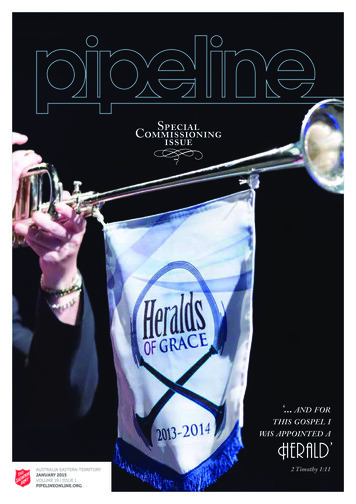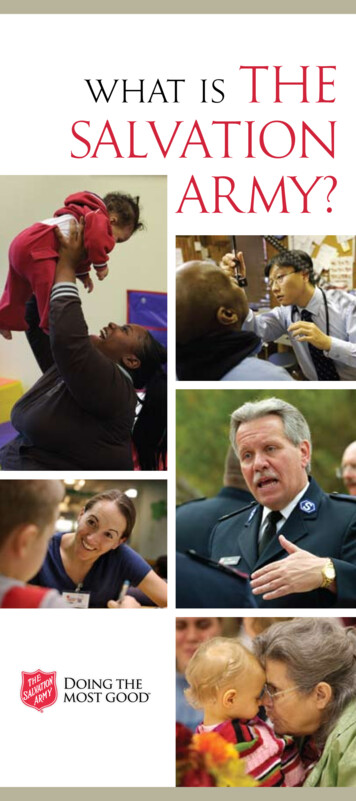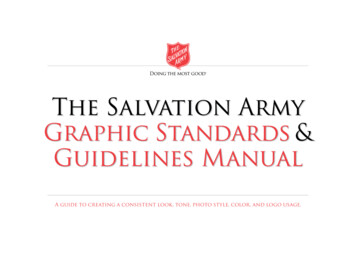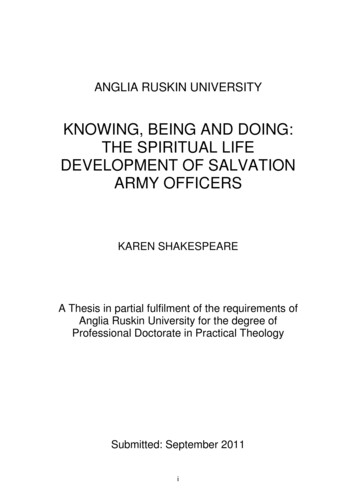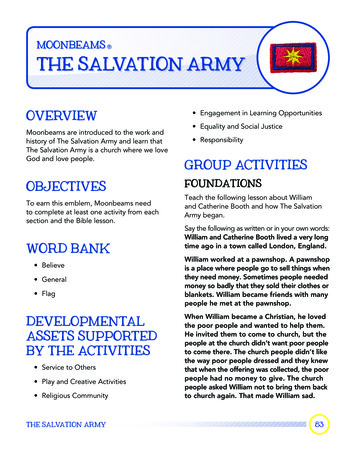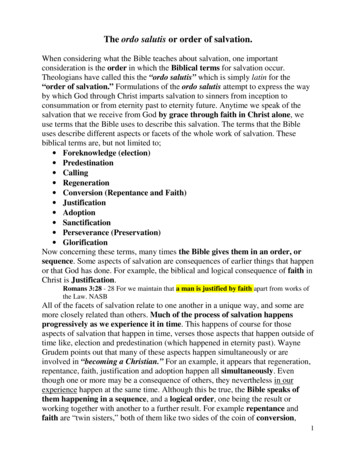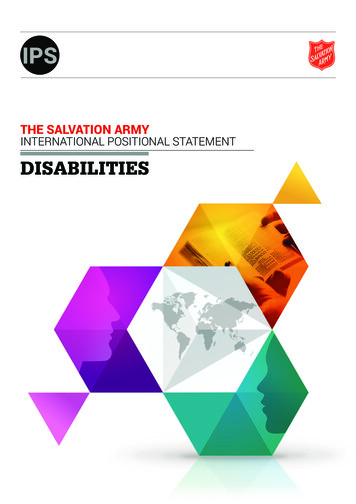
Transcription
IPSTHE SALVATION ARMYINTERNATIONAL POSITIONAL STATEMENTDISABILITIES
IPSSTATEMENT OF POSITIONAll people are made in the image of Godand are of equal intrinsic value. Thus,The Salvation Army celebrates differenceand seeks to treat all people with dignityand respect.Many people around the world experiencediscrimination due to disabilities. The realityranges from stigma or negative attitudes todeeply engrained and systemic exclusion. TheSalvation Army’s response is to go beyondminimum national legal requirements and tomake it possible for persons with disabilitiesto be fully included and to flourish.We know less of who God is and howGod appears in the world when peoplewith disabilities are excluded. Inclusion isbeneficial for everyone. Diversity within ourcommunities and congregations strengthensus and shapes our mission and ministry. Theaim of all Salvationist practice is to ensurethat we are a church that makes the embodiedgospel accessible for all.DISABILITIESTHE SALVATION ARMY INTERNATIONAL POSITIONAL STATEMENT2
BACKGROUND AND CONTEXTDisability is an historical, contemporary,cultural and global reality. It is estimated thatapproximately one billion people live with adisability.1 People with disabilities continueto face oppression in terms of injustice,economic deprivation, abuse, stigmatisationand discrimination. In some contexts, womenwith disabilities are multiply disadvantaged,many children with disabilities do not attendschool, and children with disabilities maydie at four times the rate of others. In manyparts of the world, disability legislation doesnot exist.2The word ‘disability’ can be understood asan umbrella term that includes both personalimpairments,3 and the societal restrictionsexperienced by people living with a disability.In general, ‘impairment’ is understood inmedical terms and ‘disability’ as an expressionof the exclusion between people living withdisabilities and wider society. Disability isthus not just a health problem. It is a complexphenomenon, reflecting the interactionbetween features of a person’s whole sheet-on-persons-with-disabilities.htmlWHO, International Classification of Functioning, Disabilityand Health (Geneva WHO, 2001), 10. ‘Impairmentsare problems in body function or structure such as asignificant deviation or loss.’DISABILITIES(body and mind) and features of the society inwhich he or she lives.4Numerous causes for the global reality ofdisability can be identified. These include,but are not limited to, accidents, poverty,injuries related to war and violence, pollution,cultural practices, birth defects, ageingand degenerative diseases. Addressing thedifficulties faced by people with disabilitiesrequires a combination of medical, social,environmental and cultural interventions.Language plays a significant role in shapingnarratives around disability, and there aredifferences regarding how people withdisabilities self-identify. In seeking tocommunicate the depth of our desire forinclusion, The Salvation Army strives to usethe term ‘persons with disabilities’, an exampleof ‘people-first’ language, intended to highlightpersonhood first rather than the condition ofthe person.545Article 1 of the ‘United Nations Convention on the Rights ofPersons with Disabilities’ states, ‘Persons with disabilitiesinclude those who have long-term physical, mental,intellectual or sensory impairments which in interactionwith various barriers may hinder their full and effectiveparticipation in society on an equal basis with disabilities/article-1-purpose.htmlPeople-first language, https://en.wikipedia.org/wiki/People-first languageTHE SALVATION ARMY INTERNATIONAL POSITIONAL STATEMENT3
Among others, three commonly understoodmodels of disability help us understand andrespond to the reality of disability. For example,the Medical Model organises disability aroundthe themes of medical intervention, cure,rehabilitation services and personal limitation.The Social Model understands disability aslimitation or disadvantage caused by societalstructures and attitudes, while the CulturalModel highlights the interaction of variousnotions of disability within a given culturalsetting. Meaning is then attributed to disabilityfrom within, or across cultural traditions. Insome cultural settings people with disabilitiesare considered less than human, or areconsidered to be disabled because of evilspirits, curses or sins.6difficulties encountered by people living withdisabilities.7 The World Council of Churchesalso signals the marginalisation that peoplewith disabilities experience within the churchitself and calls for ‘A Church of All and for nabledevelopment-goals/, in particular #8 and #10World Council of Churches, Gift of Being: Called to be aChurch of All and for All, entral-committee/2016/thegift-of-being; World Council of Churches, 14 October 2014Churches to be more inclusive of persons with disabilities[press release] ious international bodies are involved in thepursuit of improved outcomes for people livingwith disabilities. In 2008, the United Nations(UN) ‘Convention on the Rights of Personswith Disabilities’ was ratified by 157 countries.Amongst other things it promotes respect forthe inherent dignity of people with disabilities.In looking towards 2030 and addressingglobal challenges while seeking to ‘leaveno‑one behind,’ many of the UN’s SustainableDevelopment Goals speak directly to the6United Nations Division for Social Policy DevelopmentDepartment of Economic and Social Affairs, Toolkit onDisability for Africa: Culture, Beliefs, and Disability, LITIESTHE SALVATION ARMY INTERNATIONAL POSITIONAL STATEMENT4
GROUNDS FOR THE POSITIONOF THE SALVATION ARMYAll human beings are created in God’s ownimage, uniquely reflecting God’s nature andcharacter (Genesis 1:27-31). God’s creation issignified by diversity and that diversity is good(Genesis 1:31; Psalm 8). God loves and valuesevery person, giving each one equal dignityand worth, and commanding us to love andvalue each other.The Bible tells the story of a God who valuesthose who are outcast, powerless and weakin the eyes of society. While reflecting thecontext of its day, Scripture recognises thereal experience of exclusion that can resultfrom disability (Luke 17:11-19). The Bibleacknowledges pain and hardship as a partof the human condition (e.g. in the Book ofJob). Paul states that when we are weak,God makes us strong (2 Corinthians 12:9).Jesus showed compassion for people withdisabilities (Mark 1:41, Matthew 9:20‑25)and urged his followers to do likewise(Luke 14:12‑14). He corrected the assumptionthat disability was caused by the sin of aperson or their parents (John 9:1-3), and hechallenged social stigma by touching andeating with the socially marginalised (Matthew9:27-30; Luke 19:1-10). God’s creative intentionis that we are fulfilled in community, living inrelationship with God and each other. Pauldescribed the community of the Church asa body, stating that ‘those parts of the bodythat seem to be weaker are indispensable’(1 Corinthians 12:22 NIV). The perceivedweaker members help to shape our knowledgeof God, and without them we are less. In orderto know God more fully, everyone needs to befully included. The gift of being is profound. Itis only together with all the saints that we cancomprehend the love of God (Ephesians 3:18).DISABILITIESIn its international mission statement,The Salvation Army declares it will meethuman needs in the name of Jesus ‘withoutdiscrimination’.9 The Handbook of Doctrinedescribes the ideal of The Salvation Army’sthird doctrine as ‘God-in-community whoreaches out to create community. It is thevery basis of the inclusive gospel. Fromits beginning, The Salvation Army hasconsistently proclaimed this gospel, callingpeople of all nations to respond to the love ofGod. We seek to include and welcome into thefamily of God those who feel themselves tobe excluded from society.’ 10 It is the aim of allSalvationist practice to create communities‘which reflect the inclusiveness, genuineacceptance and mutual love of the triuneGod.’ 11 It follows that we are not a completechurch if people with disabilities are notamong he Salvation Army Handbook of Doctrine (2010), p. 75Ibid, p. 76THE SALVATION ARMY INTERNATIONAL POSITIONAL STATEMENT5
PRACTICAL RESPONSESThe Salvation Army recognises the contributionof those actively engaged in addressingissues of ignorance, neglect or discriminationagainst people living with a disability. Oneof the primary desires of people living withobservable or invisible disabilities is to betreated as ordinary human beings, created inGod’s image and called to dwell in mutuallysupportive communities. In most instances, torespond to this desire will require a collectiveshift in attitudes of both heart and mind. Suchattitudes and responses can be promoted,modelled and taught, to a certain extent. Thegoal of any response should be to eliminate adividing line between ‘us’ and ‘them’. Drawingon its theological understanding of God’s viewof people with disabilities, The Salvation Armynotes the following:1. The Salvation Army recognises the breadthof international advocacy regarding thehuman rights of people with disabilities,and seeks to better contribute to thatadvocacy, particularly in regard to theelimination of poverty and discriminationtowards people with disabilities.2. The Salvation Army embraces, promotes4. The Salvation Army seeks the engagement,consultation and active involvement ofpeople with disability when developing andframing general Salvation Army policies,human resource policies, as well as thosespecific to disability.5. The Salvation Army acknowledges that thefollowing aspects and considerations inrelation to disabilities are a necessary partof its ongoing commitment to enablingall of God’s children to flourish within theBody of Christ: Raising awarenessEngaging in specific trainingEmploying universal building designEmbracing recognised ‘best practice’communication preferencesand initiatives.6. The Salvation Army communityis encouraged to have a greaterunderstanding of the interdependenceand mutuality inherent in supportingeach other through the journey of life.We seek to respect the autonomy andself‑determination of all people.and models an understanding of personswith disabilities as people created in theimage of God, with a unique and invaluablecontribution to make in all aspects of lifein community.3. The Salvation Army fosters reciprocalministry rather than the temporarilyable-bodied ministering to people withdisabilities. We are stronger together whenwe integrate every person into every fibreof our worship and mission.DISABILITIESTHE SALVATION ARMY INTERNATIONAL POSITIONAL STATEMENT6
ADDITIONAL RESOURCESBrock, Brian, Wondrously Wounded: Theology, Disability, and the Body of Christ,Baylor University Press, Waco, Texas, 2019.Shurley, Anna Katherine, Pastoral Care and Intellectual Disability: A Person-Centered Approach,Baylor University Press, Waco, Texas, 2017.Solevåg, Anna Rebecca, Negotiating the Disabled Body: Representations of Disability in Early Christian Texts,SBL Press, Atlanta, Georgia, 2018.Yong, Amos, The Bible, Disability, and the Church: A New Vision of the People of God,Eerdmans, Grand Rapids, 2011.Approved by the General, October 2020The views expressed in this international positionalstatement constitute the official position ofThe Salvation Army on the issue addressed, and theymay not be modified or adapted in any way without theexpress written permission of International Headquarters.DISABILITIESTHE SALVATION ARMY INTERNATIONAL POSITIONAL STATEMENT7
The Salvation Army declares it will meet human needs in the name of Jesus 'without discrimination'.9 The Handbook of Doctrine describes the ideal of The Salvation Army's third doctrine as 'God-in-community who reaches out to create community. It is the very basis of the inclusive gospel. From its beginning, The Salvation Army has


